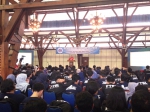Floating Structure Technology, the Solution to Indonesia’s Environmental and Energy Issues

BANDUNG, itb.ac.id – As a maritime country, Indonesia has many advantages with its natural resources. However, Indonesia poses various risks of natural disasters, ranging from floods to tsunamis.
Therefore, it is necessary to search for solutions to overcome various national matters. One of them is the technology of floating structures.
Through the 9th volume of the ITB LPPM Workshop Series, Farid Putra Bakti, Ph.D., a researcher from the Research Center for New and Renewable Energy, explained this technology on Wednesday (14/09/2022) with his presentation "Floating Structures: Pushing the Frontier of Energy Utilization, Habitable Space, and Mobility".
"These floating structures have been a lifesaver for mankind since the dawn of time. For instance, the story of the prophet Noah shows how his ark becomes a medium to save humans and other living creatures. This story is proof of the usefulness of floating structures in ancient times," the ITB FCEE lecturer explained.
As time passes, rising sea levels, supply of clean and sustainable energy, land, and food demands, as well as the mobilization of goods and people become the problems that are often encountered in daily life. "These issues can be solved using floating structures.”
One concrete example of implementing floating structures in these problems is the manufacture of large ships to cope with the growing demand for mobilization and transportation. Moreover, floating houses and cities are made to reduce land usage.
"Many countries like the Netherlands and South Korea have developed housing estates that can float in canals and the edges of the ocean," Farid added.
Problems related to the rising need for food and agricultural land can also be solved by establishing aquaculture in the open seas using floating structures. Fish farms, for example, utilize this concept while equipped with automated maintenance and surveillance systems.
Floating structure technology is not only the answer to resolving disaster, mobility, and land issues but it can also be developed to produce clean and sustainable energy in the energy sector. "Water makes up 71% of Earth’s total area. This shows that our world has an abundant source of renewable energy from water, especially the ocean," Farid elaborated.
Thus, the abundance of water can serve as an opportunity to expand renewable energy sources. A tangible form of it is the hydroelectric power generation supported by floating structures.
Floating structures of hydroelectric power plants may be found in various forms, starting from wind, current, waves, to solar power plants that are set up in the open sea.
"Floating structures play a big role and are effective in the open-sea construction of power plants because they can support many units such as solar panels, transformers, and inverters without requiring a foundation that must reach the seabed. These structures are also locked by anchors and moorings at the location.”
Other advantages of floating solar power plants are the ease of mobilization via towing, efficient land use without the need to compete with expensive residential land, being safe from natural disasters, and the better performance of solar panels thanks to the temperature of the ocean waters.
Reporter: Yoel Enrico Meiliano (Food Engineering, 2020)
Translator: Ruth Nathania (Environmental Engineering, 2019)

scan for download








